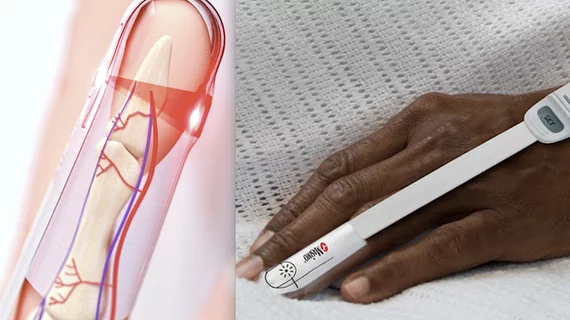Inaccurate pulse oximeter readings impact Black heart failure patients and FDA plans to address this
Heart failure providers use pulse oximeter readings to guide medication management decisions, as well as to determine whether patients are candidates for heart transplants or left ventricular assist devices (LVADs). However, racially biased readings of oxygen levels in the blood using pulse oximeters may further limit opportunities for Black patients with heart failure to receive potentially lifesaving treatments, according to a University of Michigan study published this week in Circulation: Cardiovascular Quality and Outcomes.[1]
“This is especially important because we know that Black patients are already less likely to receive heart pumps or transplants compared to their white counterparts, and these inaccurate readings can further widen a disparity that must be addressed by our healthcare system,” said first author Scott Ketcham, MD, a third year fellow in cardiovascular medicine at University of Michigan Health.
During the COVID-19 pandemic, U-M researchers found that pulse oximeters may not provide accurate readings for Black patients. In a review of adult heart failure patients treated in U-M Health’s medical and surgical cardiac ICUs between 2016 and late 2022, researchers found that pulse oximeter readings underestimated how much blood was pumping out of a patient’s heart, and overestimated the resistance in the blood vessels.
“In addition to possibly precluding Black patients from being candidates for LVADs or heart transplants, these inaccurate measurements could result in the unnecessary use of medications that affect heart and vessel function,” said co-author Matthew Konerman, MD, a heart failure cardiologist at the U-M Health Frankel Cardiovascular Center.
As changes for how pulse oximeters are evaluated and considered, the research team said the results should prompt heart failure providers to rethink their management strategies.
“For our Black patients with heart failure, we need to either measure oxygen saturation directly from the blood or use other methods to measure hemodynamics if we are using them to guide treatment of these patients,” said senior author Sarah K. Adie, PharmD, BCCP, a clinical pharmacy specialist in cardiology at U-M Health and adjunct clinical assistant professor in the U-M College of Pharmacy.
Study comes at a time when FDA is discussing racial accuracy of pulse oximeters
This study is timely because, on Feb. 2, the U.S. Food and Drug Administration (FDA) held a public advisory committee meeting to discuss this known issue and come up with ways to improve methods used to evaluate the performance of pulse oximeters with respect to skin pigmentation, race and ethnicity. COVID magnified health disparities across the board and brought these issues to the forefront of people's minds. The concerns included inaccuracies owing to skin color.
Multiple factors can interfere with pulse oximetry accuracy including, vasoconstriction, vasodilation, anemia, edema and skin pigmentation, explained Theresa Davis, PhD, RN, NE-BC, CHTP, FAAN, president of the American Association of Critical-Care Nurses, and assistant vice president of nursing at the High Reliability Center of Inova Health System, who presented at the FDA meeting. She cited substantial evidence showing significant inaccuracy among patients who identify as Black, Asian or Hispanic.[2,3,4]
Ashraf Fawzy, MD, MPH, assistant professor of medicine, Division of Pulmonary and Critical Care, Johns Hopkins University, presented data from a study he conducted and was referenced by many of the speakers at the FDA meeting.[3] His research during COVID looked at the level of racial bias in pulse oximetry and its clinical consequence in the real world. His data show SpO2 oximetery readings are overestimated by 1.7% in Asians, 1.2% in Blacks and 1.1% in Hispanics. The study also found accuracy of pulse oximetry was off by an average of 0.95% for Blacks, 0.49% Hispanics and 0.53% in Asians. These discrepancies caused a whopping 54.8% of Black patients to not be recognized as needing treatment for COVID-19, compared to 17.3% for whites. The study found pulse oximetery also under recognized the need for COVID treatment in 27.1% of Hispanics. Interestingly, the study found just 0.9% of Asians were not recognized as needing treatment.
While studies report differences in occult hypoxemia by race and ethnicity, it is more accurately related to the degree of skin pigmentation, Davis said. For this reason the focus of the FDA meeting was to create criteria for clinical study to look at how to improve accuracy of pulse ox readings in patients with darker skin tones. The study will be based on a validated scale, using the Monk Skin Tone (MST) scale. Measurement of skin pigmentation at the sensor site will be by assessing the Individual Typology Angle (ITA).
Some vendors, including Masimo, attended the meeting and plan to participate in the upcoming trial so they can refine their technology and improve the clinical accuracy of their devices.

